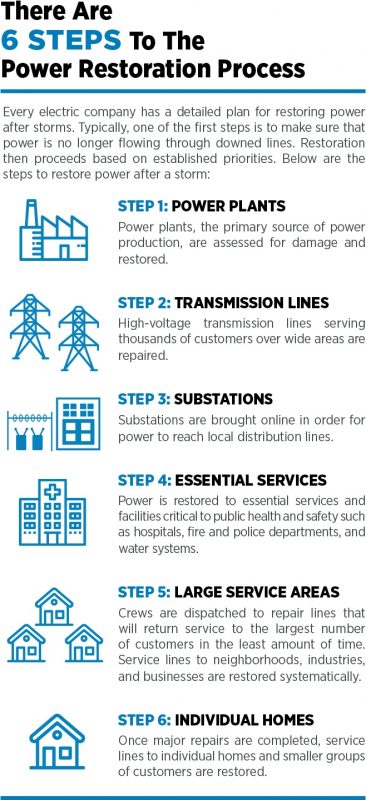Duke Energy won’t rest until power restored to customers rocked by Hurricane Irma

As Florida struggles to recover from the wrath of Hurricane Irma, Duke Energy is pushing forward to restore electricity to its customers as quickly as possible, with thousands of lineworkers, support personnel, and resources from around the country at their side.
“One thing we focus on in this industry is that idea that this is all of us,” Duke Energy’s Director of Regional Communications Tim Pettit said in an interview with Daily Energy Insider. “We’ve all been through this before.”
Duke Energy reported that of the 1.28 million of their customers without power, just over a million have been restored. More than 12,000 workers from the Midwest, the Carolinas, Louisiana, Colorado, Oklahoma, Minnesota, New York, and even Canada, are still running round-the-clock rotations to get power restored to customers that can receive electricity by Duke’s estimated time of restoration on Sunday night.
“There are customers coming back on little by little, but there’s no magic switch that fixes the entire power grid,” Pettit said. “It’s a methodical process to get the power back on, but, with the exception of the hardest hit counties with significant infrastructure damage, we’re working hard to get to that Sunday goal for the vast majority.”
Pettit said that while there may be repairs that will need additional attention, such as temporary transformers, most of that work will be fixed without any further impact or disruption to the customers. Additionally, he stated that customers who are not able to receive power due to a damaged meter box or transformer, should contact a licensed electrician to reconnect their home’s power connections.
Hurricane Irma, a Category 5 storm at its peak, developed on Aug. 30 near the Cape Verde Islands. By Sept. 6, Irma’s path towards Florida, had been determined. The restoration process is the largest the state of Florida has ever seen due to the magnitude of Hurricane Irma, which impacted all 67 counties in the state.
“Because we were looking at the forecasting and tracking, we were able to get an idea of which areas would be impacted and where we were going to need the most immediate support,” Pettit said.
By the time Irma hit the Florida coast, tens of thousands of utility personnel had been set up in “pre-staging” areas in and around the state. Their placement allowed for the assistance crews to ride out the storm safely and be set up to immediately begin assessing the damage as soon as the storm had passed, Pettit said.
“This is a common thing among all utilities, working collectively like this,” Pettit said. “There’s no way any utility would be able to maintain a workforce that’s great enough to take on the force of a storm like Irma. You have to apply resources and rely on outside assistance.”
Duke Energy, with its Florida regional headquarters based in St. Petersburg, is one of the largest electric power holding companies in the United States. The company is a member of the Edison Electric Institute (EEI), the national association that represents all U.S. investor-owned electric utility companies.
“We’re problem solvers,” Scott Aaronson, executive director of security and business continuity at EEI, said. “We connect the teams, companies, and CEOs when there’s trouble in a specific area. The CEOs who work with us have that mentality of: ‘If one of us fail, we all fail.’”
One of the first assessments that had to be made immediately following the storm was determining whether the electricity generation of the state’s utilities was still functional, Aaronson said.
“We quickly found out that the utilities were still able to make electricity, which is what we want to see after a storm like this,” Aaronson told Daily Energy Insider. “The actual distribution and delivery to the customer is what’s happening now and that’s going to take some time.”
At the height of crisis on Sept. 11, 7.8 million electric customers throughout the state reported outages. That number is now at 1.7 million in Florida and Georgia, according to EEI.
“That was largely because of fixes upstream, in the transmission systems and substations, bringing large sections up all at once,” Aaronson said. The slower aspect of the repairs involves the resetting of damaged poles and lines. “So as the larger numbers begin to trail off, we’re asking customers for patience as the army of workers go into the neighborhoods.”
Aaronson added, “Crews upstream are doing incredible work that will impact your neighborhood. We know people are getting frustrated, but we want them to know that we feel their pain. We live and work in the communities we serve. And we’re seeing tens of thousands of those linemen and personnel working as hard, as quickly, and as safely as they can.”
Customers should remember that even if utility workers can’t be seen, it doesn’t mean all efforts are not being taken to get customers’ power back on, Aaronson said.
The electric industry will learn through its power restoration and review process, which will include an examination of local infrastructure. Many of the practices that went into shaping the recent response were learned in the aftermath of Superstorm Sandy, which hit the Northeast in October 2012, and lessons are going to be learned from Irma as well.
“Mother nature is going to have her way and we can’t stop that,” Aaronson said. “But we can manage it.”
